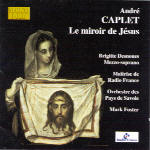Today we tend to think of André Caplet as a second rank Debussy, failing to realize that the composer died at a very young age, just as he was reaching the peak of his powers. After all, he did win the Grand Prix du Rome in 1901, when Maurice Ravel placed second! Caplet devoted most of his compositional energy to religious music, and Le miroir de Jésus emerges as his spiritual masterpiece. Cast in three sections, it is fashioned after the Rosary, its tripartite structure divided into sequences devoted to the birth of Jesus, his Passion and crucifixion, and the Resurrection. Each section is announced by the chorus, leading to an instrumental prelude, after which the mezzo-soprano sings five sonnets to texts by Henri Ghéon.
Though the piece is economically orchestrated for just strings and harp, Caplet manages to pull off an incredibly broad range of emotions and sounds. The prelude to the Nativity section, for instance, is all shimmering strings and comfortable harmonies replete with harp glissandos, whereas the somber prelude to the Passion, the Mirror of Suffering, offers the strings playing long, bleak lines in unison. When the harp does enter in the first sonnet, it is at the bottom of its range in ominous bass notes played close to the sounding-board. The orchestral colors are fully realized in this expert performance, in which everything seems to be in exactly the right place. Mezzo-soprano Brigitte Desnoues displays a warm, well-focused voice used with intelligence yet no lack of passion, and the small chorus adds many atmospheric and ethereal interjections along the way, as called for in the score. The recorded sound is just a bit remote, but it’s clean and clear. In sum, this lovely composition is quite a discovery.
































